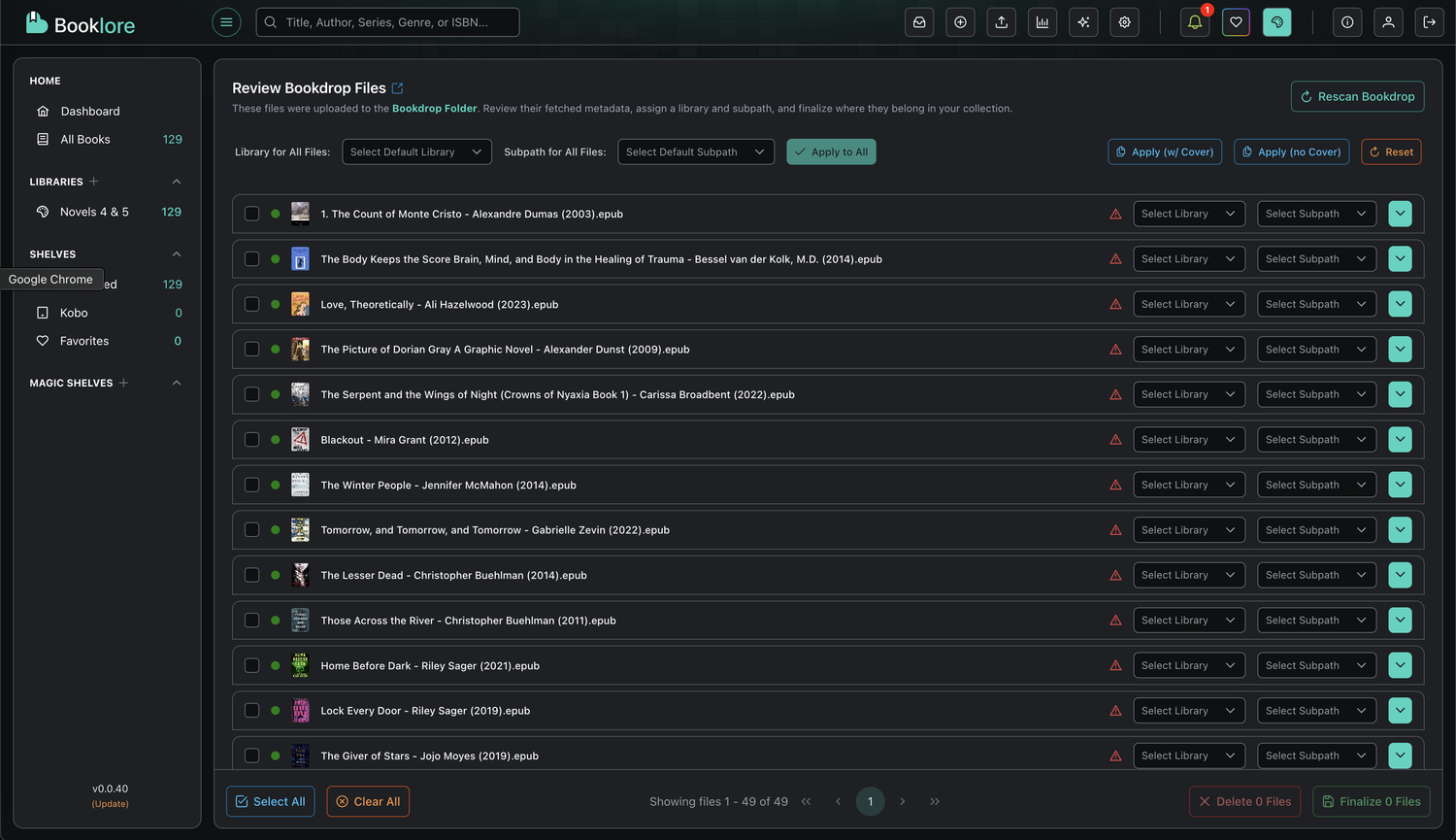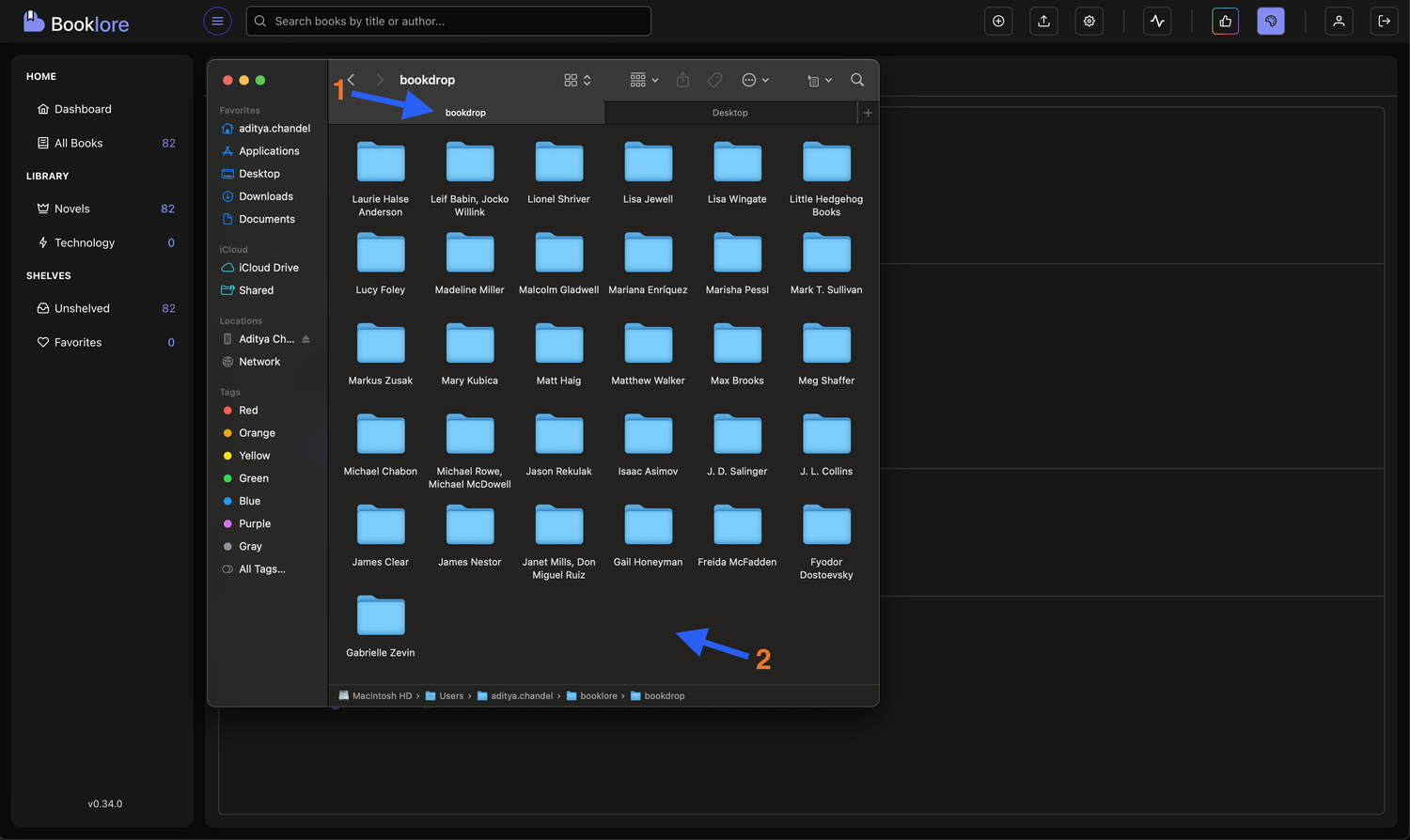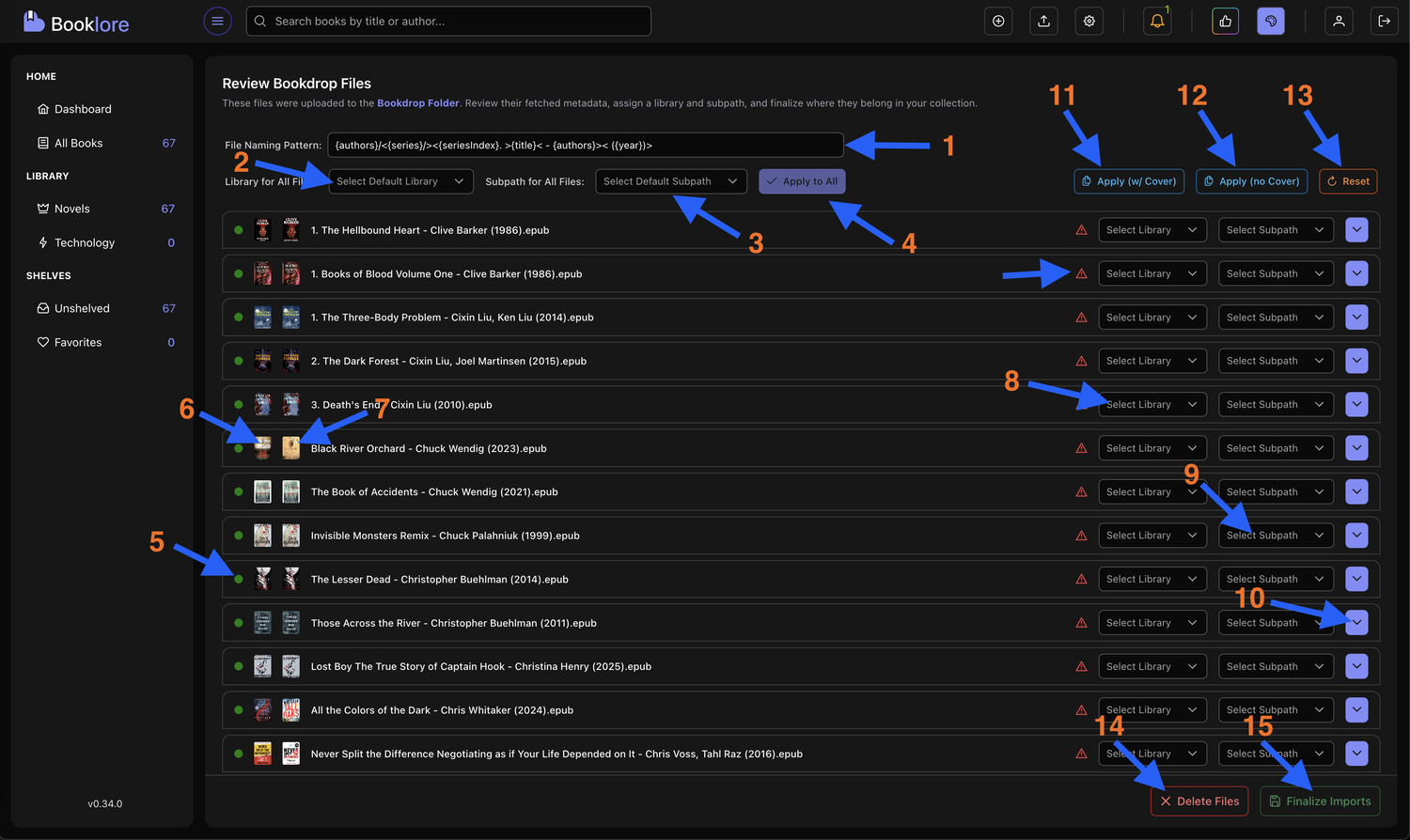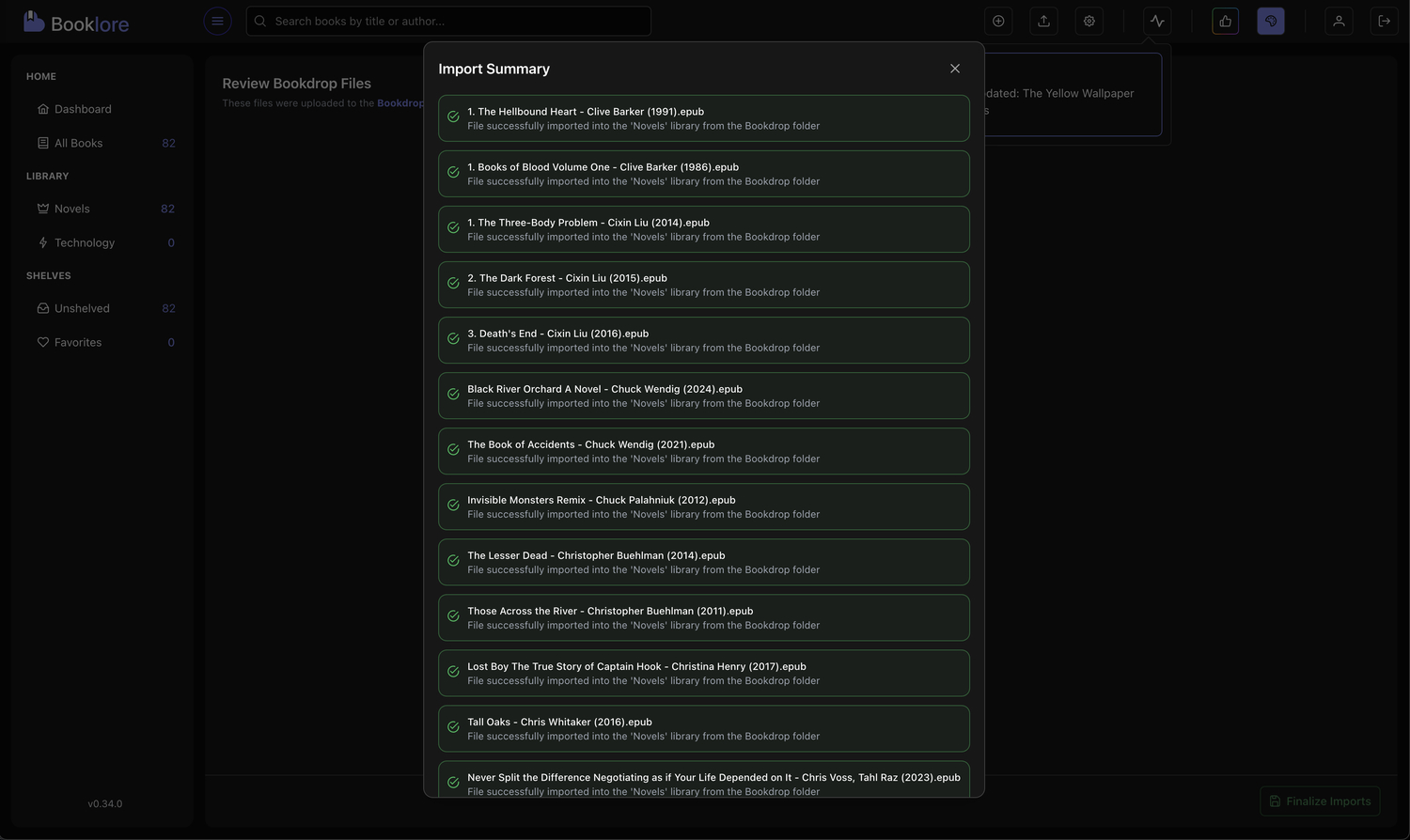📥 Bookdrop
Effortlessly add books to your library by simply dropping files into a folder. No manual uploads, no tedious clicking, just drop, review, and import. Bookdrop automates metadata extraction, enrichment, and organization, making library management a breeze.

Bookdrop may not reliably detect new files on network-mounted storage (e.g., NFS or SMB). Many network filesystems do not propagate real-time filesystem events to the host process, so Bookdrop may not notice newly added files.
If Bookdrop doesn't react when you add files:
- Use a local folder instead
- Adjust mount options to enable notification support
- Restart Booklore to trigger a manual rescan
- Open the Bookdrop UI and click the manual "Refresh" button to force a reload
Drop entire folders of books at once. Bookdrop processes them sequentially and queues everything for easy review.
🌟 What You'll Achieve
With Bookdrop, you can:
- Import books automatically without manual uploads
- Process multiple books at once by dropping entire folders
- Enrich metadata automatically from online sources like Google Books
- Review and refine metadata before finalizing imports
- Organize books instantly with smart library and subfolder assignments
- Maintain clean libraries with customizable filename patterns
✨ How Bookdrop Works
🔄 The Automated Pipeline
-
📡 Real-Time Monitoring
A background file watcher continuously scans your Bookdrop folder for new files. -
🧠 Smart Detection
When files appear, Booklore extracts metadata from filenames and embedded tags. -
🌐 Automatic Enrichment
If enabled, Booklore queries Google Books and Open Library to enhance metadata with covers, descriptions, and more. -
📋 Queue for Review
All detected books appear in the Bookdrop UI for your review and approval. -
✅ Finalize Import
After reviewing, books are renamed, organized, and moved to their designated libraries.
🚀 Getting Started
Step 1: Configure the Bookdrop Folder
If you're using Docker, mount a local directory as your Bookdrop path in docker-compose.yml:
services:
booklore:
# ...existing configuration...
volumes:
- /your/local/path/to/booklore/data:/app/data
- /your/local/path/to/booklore/books:/books
- /your/local/path/to/booklore/bookdrop:/bookdrop # Bookdrop directory
Ensure the Bookdrop folder has proper read/write permissions for the Booklore container.
Step 2: Add Books to Bookdrop
Adding books is as simple as copying files:
-
Locate Your Bookdrop Folder
Find the folder on your system (as configured in Step 1) -
Drop Your Books
Copy any supported book files (.pdf,.epub,.cbz,.mobi, etc.) into the folder -
Drop Folders Too
You can drop entire folders containing multiple books, Booklore processes them all

PDF, EPUB, CBZ, CBR, and CB7 are supported.
Step 3: Monitor Processing Progress
Booklore automatically detects and processes dropped files. Track progress in real-time:

-
Open Notifications
Click the 🔔 bell icon in the top-right corner -
View Current Status
- Currently processing book
- Books remaining in queue
- Books successfully processed
-
Access Review
When processing completes, click the "Review" button to open the Bookdrop UI
Varies based on file size, number of books, and metadata enrichment settings. Most books process in seconds.
📖 Understanding the Bookdrop UI
Interface Overview
The Bookdrop UI is your control center for reviewing and finalizing imports. Let's explore each component:

🎯 Global Settings (Top Section)
1. Filename Pattern Preview
Shows how books will be renamed based on your configured pattern. Patterns use metadata fields like {title}, {author}, and {year}.
Edit patterns in Settings → Metadata Settings to control how books are renamed.
2. Default Library Selection
Choose which library all books should be imported into. This applies to all books unless overridden individually.
3. Default Subfolder Selection
Optionally specify a subfolder within the library (e.g., "Sci-Fi", "Non-Fiction") for better organization.
4. Apply Defaults to All
Click this button to apply the selected library and subfolder to every book in the list. Individual overrides remain respected.
📚 Per-Book Controls (Middle Section)
Each book in the list has individual controls:
5. Metadata Status Indicator
A colored dot shows metadata quality:
- 🟢 Green: Metadata successfully fetched from online sources
- 🟡 Yellow: Only internal metadata available (from filename/embedded tags)
6. Fetched Cover Preview
The book cover retrieved from online sources (Google Books, Open Library)
7. Internal Cover Preview
The cover image embedded within the book file itself
Compare both covers to choose the best quality one for your library.
8. Per-Book Library Override
Assign individual books to different libraries (overrides the default)
9. Per-Book Subfolder Override
Assign individual books to different subfolders (overrides the default)
10. Metadata Comparison Panel
Opens a detailed side-by-side view of fetched vs. internal metadata for precise control
🛠️ Bulk Action Buttons (Bottom Section)
11. Apply All Metadata (with Cover)
Copies all fetched metadata including covers to all books. Use when confident in online data quality.
12. Apply All Metadata (without Cover)
Applies fetched metadata but keeps original embedded covers. Best for books with high-quality embedded covers.
13. Reset All Metadata
Reverts all changes made during this session, restoring original file-based values.
14. Delete All
Clears the entire Bookdrop queue and discards all pending metadata. Original files remain on disk.
This clears your review queue but doesn't delete the actual files from disk.
15. Finalize Import
Begins the import process: moves files to libraries, applies metadata, and renames files. Progress shows in notifications.
16. Post-Import Cleanup
After successful import, original files are automatically removed from Bookdrop to prevent reprocessing.
🎨 Advanced Metadata Management
Per-Book Metadata Comparison
For granular control over individual books, use the metadata comparison dropdown:

1. Open Metadata Picker
Click the dropdown icon next to any book to reveal the comparison panel.
2. Auto-Fill Missing Fields (Single Arrow)
Copies only missing fields from fetched metadata. Existing values remain unchanged.
Example:
Current: Title="Book", Author=""
Fetched: Title="The Book", Author="John Doe"
Result: Title="Book", Author="John Doe" ← Only author copied
3. Overwrite All Fields (Double Arrow)
Replaces all fields with fetched metadata. Use when fetched data is more accurate.
Example:
Current: Title="Book", Author="Unknown"
Fetched: Title="The Book", Author="John Doe"
Result: Title="The Book", Author="John Doe" ← Everything replaced
4. Visual Feedback
Fields that have been updated are highlighted in green for easy tracking.
5. Copy Individual Fields
Use the copy button next to specific fields to selectively update only what you want.
Review the comparison for important books or when automatic enrichment seems uncertain.
✅ Finalizing the Import
Step 4: Review Import Summary
After clicking "Finalize Import", Booklore processes all books and displays a comprehensive summary:

The summary includes:
-
✅ Successfully Imported Books
Books that were processed and added to your libraries -
📚 Library & Subfolder Placement
Where each book was stored in your collection -
⚠️ Skipped or Ignored Books
Files that couldn't be processed or were duplicates -
📊 Processing Statistics
Total counts and success rates
Your books are now in your library and ready to read.
Remember: Bookdrop is designed to make book management effortless. Drop files, review metadata, and build your perfect library with minimal effort. Happy reading! 📚✨